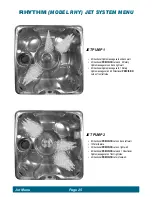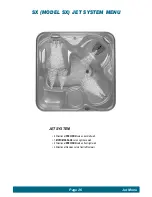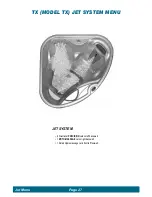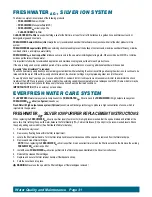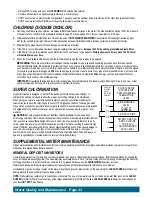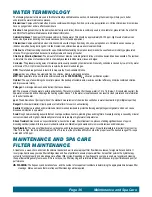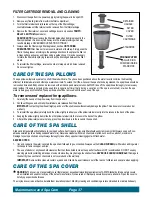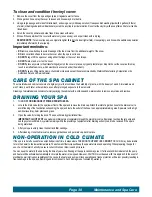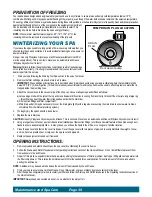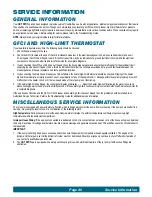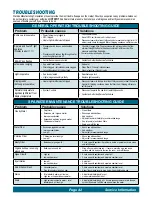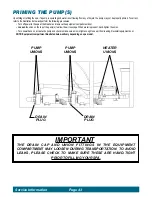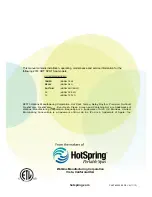
Maintenance and Spa Care
page 39
prEvEnTIon oF FrEEzIng
your spa has been designed and engineered for year-round use in any climate. In some areas, extremely cold temperatures (below 10°F)
combined with strong wind, may cause partial freezing of the jet pump, even though the water inside the spa remains at the selected temperature.
The energy efficiency of the spa may also decrease during these cold periods, as the heater will cycle more frequently. As an additional precaution
against partial freezing of some of the components, the equipment compartment
can be insulated with an insulating kit (available from your local dealer). This
insulating kit will also help to maximize the spa’s energy efficiency.
Note:
When warmer weather returns (approx. 60°-70°F, 15.5º-21ºc), the
insulating kit must be removed to prevent overheating of the jet pump.
WINTERIzING YOUR SPA
If you leave the spa unused for a long period of time in severely cold weather, you
should drain the spa and winterize it to avoid accidental freezing due to a power or
equipment failure.
danger: use only Propylene Glycol as your anti-freeze (available at most RV or
marine supply stores). This is non-toxic. Never use an automobile anti-freeze
(ethylene Glycol) since it is toxic!
Warning:
Failure to follow these instructions correctly can lead to freeze damage
not covered by warranty. It is strongly recommended that you contact your local
dealer to perform this service
1. Drain your spa following the Draining Your Spa section in the owner’s manual.
2. Remove the filter cartridge, clean and store in a dry place.
ImpoRtaNt:
These additional instructions must be utilized when draining and winterizing your spa in climates where the temperature falls
below 32°F (0°c). A five (5) gallon (19 liters) combination (vacuum/blower) wet/dry shop vac must be used to effectively remove water that is
trapped inside the plumbing lines.
3. Attach the vacuum hose to the vacuum side of the shop vac. Vacuum all openings and orifices as follows:
a) Jet openings: start with the jets at the top and move downward (if suction is coming from another jet, block off the other jet using a large rag
– this will help pull out the water that is trapped deeper inside the main line).
b) Filter suction fittings and filter compartment.
c) Main drain outlet (it may be necessary to cover the drain grate tightly with a rag when vacuuming the main drain to ensure water is drawn
completely from the internal plumbing system).
4. Thoroughly dry the spa shell with a clean towel.
5. Replace the main drain cap.
CaUtIoN:
use only Propylene Glycol as your anti-freeze. This is non-toxic. Never use an automobile anti-freeze (ethylene Glycol) since it is toxic!
6. using a long-extension funnel, pour anti-freeze into all standpipes, filter suction fittings, jet orifices and water feature orifices. Add enough anti-
freeze to ensure adequate protection – in many cases, you will see the liquid in the orifice, or coming out of another location.
7. close the spa cover and fasten the cover tie downs. cover the spa cover with two pieces of plywood to evenly distribute the weight of snow
and ice. secure a plastic sheet, or tarp, over the spa cover and plywood.
8. Replace the equipment access door, if removed.
opEnIng InSTruCTIonS:
1. Remove plywood and plastic sheet. open the spa cover by unfastening the cover tie downs.
2. Follow the Start-up and Refill Procedures in the Operating Instructions section of the Owner’s Manual. Do not install filters to prevent them
from exposure to the anti-freeze.
3. As part of this process, superchlorinate the spa water by adding three teaspoons of chlorine (sodium dichlor) per 250 gallons of spa water into
the filter compartment. This is twice the normal amount of chlorine needed for superclorination. This extra amount of chlorine is needed to
destroy the anti-freeze.
Note:
A defoamer may be needed to decrease the amount of foam caused by the anti-freeze.
4. drain your spa to ensure removal of anti-freeze. do not drain water on grass or plants due to excessive chlorine level.
5. After the spa has completely drained, re-install your filter and follow the start-up and Refill Procedures in the operating Instructions section of
the Owner’s Manual.
ImpoRtaNt:
Always keep spa covered when not in use, whether it is empty or full.
Front view of pump
dRAIN
PLuG
pUmp DRaIN plUG loCatIoN
Summary of Contents for 2014 REL
Page 1: ...2014 Owner s Manual...
Page 47: ......

